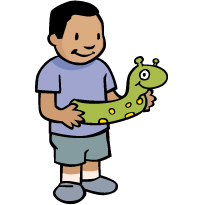Boston Children's Museum
308 Congress Street, Boston, MA 02210
617-426-6500
© Boston Children’s Museum 2025
Website Design by Jackrabbit
Spring is a time of rebirth and renewal—and eggs! Many animals lay and incubate eggs in the spring, and in some cultures spring is a time in which kids paint, hide and eat lots of eggs. This makes it a great time to not only take a close look at eggs, but also to experiment with some of the things we can do with them. This activity is the first in the Incredible Egg series of activities, which are designed to be done during the Spring—start your students off with this and other “egg science” activities, then move on to egg art, and finally take the Egg Drop Challenge!
VIEW ACTIVITY
Focusing on characteristics of living things (food, shelter/protection, methods of gathering food, etc), this activity gives kids a chance to construct a 3-D model of the living things that they invented in the “Design a Critter” activity. Students will have an opportunity to practice observation and problem solving skills as well as tool use and materials manipulation. And, they get to be creative!
VIEW ACTIVITY
No matter where you are, a surprising array of living things occupies the same space. In the city, in the country, in the suburbs—many species of insect, arachnid, worm and other organisms can be found if you take the time to look. Giving children the opportunity to do an inventory of these creatures not only familiarizes them with living things and classification, but instills in them a sense of place and an understanding of and an appreciation for their home environment.
VIEW ACTIVITY
Engineering activities give kids a chance to develop problem solving and observations skills, to work with interesting and engaging tools and materials, and to learn how to work as a member of a team. In this activity, your students will get to do all of that as they are challenged to protect an egg from breaking after it is dropped from a set height. This activity is part of the Incredible Egg series of activities, which are designed to be done during the Spring.
VIEW ACTIVITY
Spring is a time of rebirth and renewal—and eggs! Many animals lay and incubate eggs in the spring, and in some cultures spring is a time in which kids paint, hide and eat lots of eggs. This makes it a great time to not only take a close look at eggs, but also to experiment with some of the things we can do with them. This activity is part of the Incredible Egg series of activities, which are designed to be done during the Spring—start your students off with some of the “egg science” activities, then move on to “egg art”, and finally take the Egg Drop Challenge!
VIEW ACTIVITY
Spring is a time of rebirth and renewal—and eggs! Many animals lay and incubate eggs in the spring, and in some cultures spring is a time in which kids paint, hide and eat lots of eggs. This makes it a great time to not only take a close look at eggs, but also to experiment with some of the things we can do with them. This activity is part of the Incredible Egg series of activities, which are designed to be done during the Spring—start your students off with this and other “egg science” activities, then move on to egg art, and finally take the Egg Drop Challenge!
VIEW ACTIVITY
After being outside a few times, kids will know a lot more about the characteristics of the living things that inhabit their afterschool neighborhood. Focusing on what living things need (food, shelter/protection, methods of gathering food, etc.), this activity asks kids to invent a brand new creature that would be able to survive in the area around their afterschool. In the next activity, they have a chance to construct their new critter out of recycled material.
VIEW ACTIVITY
Designing and building small boats out of clay gives children a chance to practice critical observation skills, problem solving skills and communication skills as they work with their teammates. In addition, children are asked to manipulate an intrinsically interesting material that at first seems not quite right for the job—until they explore a little more and discover the possibilities.
VIEW ACTIVITY
Even very young children can fold a sheet of aluminum foil into a shape that will float. Adapting the boat for improved performance requires a little more dexterity and an ability to observe and make conclusions about the materials and their functions. In addition measurement, record keeping and problem solving skills are all required in this simple activity.
VIEW ACTIVITY
Are bubbles always round? Does a bubble look the same in the air as it does on the table, or in a soda bottle—or in a cube? Experiment with these materials and find out!
VIEW ACTIVITY